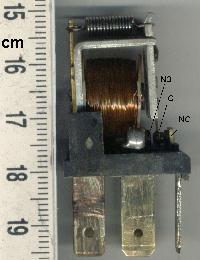|
Piezoelectricity
Piezoelectricity (, ) is the electric charge that accumulates in certain solid materials—such as crystals, certain ceramics, and biological matter such as bone, DNA, and various proteins—in response to applied mechanical stress. The piezoelectric effect results from the linear electromechanical interaction between the mechanical and electrical states in crystalline materials with no inversion symmetry. The piezoelectric effect is a reversible process: materials exhibiting the piezoelectric effect also exhibit the reverse piezoelectric effect, the internal generation of a mechanical strain resulting from an applied electric field. For example, lead zirconate titanate crystals will generate measurable piezoelectricity when their static structure is deformed by about 0.1% of the original dimension. Conversely, those same crystals will change about 0.1% of their static dimension when an external electric field is applied. The inverse piezoelectric effect is used in the pro ... [...More Info...] [...Related Items...] OR: [Wikipedia] [Google] [Baidu] |
List Of Piezoelectric Materials
This page lists properties of several commonly used piezoelectric materials. Piezoelectric materials (PMs) can be broadly classified as either crystalline, ceramic, or polymeric. The most commonly produced piezoelectric ceramics are lead zirconate titanate (PZT), barium titanate, and lead titanate. Gallium nitride and zinc oxide can also be regarded as a ceramic due to their relatively wide band gaps. Semiconducting PMs offer features such as compatibility with integrated circuits and semiconductor devices. Inorganic ceramic PMs offer advantages over single crystals, including ease of fabrication into a variety of shapes and sizes not constrained crystallographic directions. Organic polymer PMs, such as PVDF, have low Young's modulus compared to inorganic PMs. Piezoelectric polymers (PVDF, 240 mV-m/N) possess higher piezoelectric stress constants (''g''33), an important parameter in sensors, than ceramics (PZT, 11 mV-m/N), which show that they can be better sensors than ceramics. ... [...More Info...] [...Related Items...] OR: [Wikipedia] [Google] [Baidu] |
Ultrasonic Nozzle
Ultrasonic nozzles are a type of spray nozzle that use high frequency vibrations produced by piezoelectric transducers acting upon the nozzle tip that create capillary waves in a liquid film. Once the amplitude of the capillary waves reaches a critical height (due to the power level supplied by the generator), they become too tall to support themselves and tiny droplets fall off the tip of each wave resulting in atomization. The primary factors influencing the initial droplet size produced are frequency of vibration, surface tension, and viscosity of the liquid. Frequencies are commonly in the range of 20–180 kHz, beyond the range of human hearing, where the highest frequencies produce the smallest drop size. History In 1962 Dr. Robert Lang followed up on this work, essentially proving a correlation between his atomized droplet size relative to Rayleigh's liquid wavelength. Ultrasonic nozzles were first commercialized by Dr. Harvey L. Berger. . Applications Subseque ... [...More Info...] [...Related Items...] OR: [Wikipedia] [Google] [Baidu] |
Pierre Curie
Pierre Curie ( ; ; 15 May 1859 – 19 April 1906) was a French physicist, Radiochemistry, radiochemist, and a pioneer in crystallography, magnetism, piezoelectricity, and radioactivity. He shared the 1903 Nobel Prize in Physics with his wife, Marie Curie, and Henri Becquerel "in recognition of the extraordinary services they have rendered by their joint researches on the radiation phenomena discovered by Professor Henri Becquerel". With their win, the Curies became the Nobel Prize#Statistics, first married couple to win a Nobel Prize, launching the Nobel Prize#Family laureates, Curie family legacy of five Nobel Prizes. Early life Born in Paris on 15 May 1859, Pierre Curie was the son of Eugène Curie (1827–1910), a doctor of French Huguenot Protestant origin from Alsace, and Sophie-Claire Curie (née Depouilly; 1832–1897). He was educated by his father and in his early teens showed a strong aptitude for mathematics and geometry. When he was 16, he earned his Bachelor of ... [...More Info...] [...Related Items...] OR: [Wikipedia] [Google] [Baidu] |
Inkjet Printing
Inkjet printing is a type of computer printing that recreates a digital image by propelling droplets of ink onto paper or plastic substrates. Inkjet printers were the most commonly used type of printer in 2008, and range from small inexpensive consumer models to expensive professional machines. By 2019, laser printers outsold inkjet printers by nearly a 2:1 ratio, 9.6% vs 5.1% of all computer peripherals. The concept of inkjet printing originated in the 20th century, and the technology was first extensively developed in the early 1950s. While working at Canon in Japan, Ichiro Endo suggested the idea for a "bubble jet" printer, while around the same time Jon Vaught at Hewlett-Packard (HP) was developing a similar idea. In the late 1970s, inkjet printers that could reproduce digital images generated by computers were developed, mainly by Epson, HP and Canon. In the worldwide consumer market, four manufacturers account for the majority of inkjet printer sales: Canon, HP, Ep ... [...More Info...] [...Related Items...] OR: [Wikipedia] [Google] [Baidu] |
Lead Zirconate Titanate
Lead zirconate titanate, also called lead zirconium titanate and commonly abbreviated as PZT, is an inorganic compound with the chemical formula . It is a ceramic perovskite material that shows a marked piezoelectric effect, meaning that the compound changes shape when an electric field is applied. It is used in a number of practical applications such as ultrasonic transducers and piezoelectric resonators. It is a white to off-white solid. Lead zirconium titanate was first developed around 1952 at the Tokyo Institute of Technology. Compared to barium titanate, a previously discovered metallic-oxide-based piezoelectric material, lead zirconium titanate exhibits greater sensitivity and has a higher operating temperature. Piezoelectric ceramics are chosen for applications because of their physical strength, chemical inertness and their relatively low manufacturing cost. PZT ceramic is the most commonly used piezoelectric ceramic because it has an even greater sensitivity and higher ... [...More Info...] [...Related Items...] OR: [Wikipedia] [Google] [Baidu] |
Electromechanical
Electromechanics combine processes and procedures drawn from electrical engineering and mechanical engineering. Electromechanics focus on the interaction of electrical and mechanical systems as a whole and how the two systems interact with each other. This process is especially prominent in systems such as those of DC or AC rotating electrical machines which can be designed and operated to generate power from a mechanical process ( generator) or used to power a mechanical effect ( motor). Electrical engineering in this context also encompasses electronics engineering. Electromechanical devices are ones which have both electrical and mechanical processes. Strictly speaking, a manually operated switch is an electromechanical component due to the mechanical movement causing an electrical output. Though this is true, the term is usually understood to refer to devices which involve an electrical signal to create mechanical movement, or vice versa mechanical movement to create an ele ... [...More Info...] [...Related Items...] OR: [Wikipedia] [Google] [Baidu] |
Solid
Solid is a state of matter where molecules are closely packed and can not slide past each other. Solids resist compression, expansion, or external forces that would alter its shape, with the degree to which they are resisted dependent upon the specific material under consideration. Solids also always possess the least amount of kinetic energy per atom/molecule relative to other phases or, equivalently stated, solids are formed when matter in the liquid / gas phase is cooled below a certain temperature. This temperature is called the melting point of that substance and is an intrinsic property, i.e. independent of how much of the matter there is. All matter in solids can be arranged on a microscopic scale under certain conditions. Solids are characterized by structural rigidity and resistance to applied external forces and pressure. Unlike liquids, solids do not flow to take on the shape of their container, nor do they expand to fill the entire available volume like a gas. Much ... [...More Info...] [...Related Items...] OR: [Wikipedia] [Google] [Baidu] |
Ceramic
A ceramic is any of the various hard, brittle, heat-resistant, and corrosion-resistant materials made by shaping and then firing an inorganic, nonmetallic material, such as clay, at a high temperature. Common examples are earthenware, porcelain, and brick. The earliest ceramics made by humans were fired clay bricks used for building house walls and other structures. Other pottery objects such as pots, vessels, vases and figurines were made from clay, either by itself or mixed with other materials like silica, hardened by sintering in fire. Later, ceramics were glazed and fired to create smooth, colored surfaces, decreasing porosity through the use of glassy, amorphous ceramic coatings on top of the crystalline ceramic substrates. Ceramics now include domestic, industrial, and building products, as well as a wide range of materials developed for use in advanced ceramic engineering, such as semiconductors. The word '' ceramic'' comes from the Ancient Greek word (), meaning ... [...More Info...] [...Related Items...] OR: [Wikipedia] [Google] [Baidu] |
Jacques Curie
Jacques Curie (29 October 1855 – 19 February 1941) was a French physicist and professor of mineralogy at the University of Montpellier. Along with his younger brother, Pierre Curie, he studied pyroelectricity in the 1880s, leading to their discovery of some of the mechanisms behind piezoelectricity. He is buried in the Saint-Lazare cemetery in Montpellier. Biography In 1883, Jacques Curie was appointed professor of mineralogy at the University of Montpellier. This appointment marked the end of his collaboration with his brother Pierre. He remained in Montpellier until his death in 1941 with the exception of the years 1887–1889, which he spent in Algeria, teaching at the School of Science of Algiers and conducting his research. It was not until 1903 that he was appointed to the chair of physics, a position he retained until his retirement in 1925. His son Maurice Curie was a physicist. Research and discoveries The major legacy of Jacques Curie is the discovery of the ... [...More Info...] [...Related Items...] OR: [Wikipedia] [Google] [Baidu] |
Trigger (drums)
In drumming, a trigger is an electronic transducer that can be attached to a drum, cymbal or other instrument to enable it to control an electronic drum unit or similar device. Specialised triggers are produced for specific instruments. A snare drum The snare drum (or side drum) is a percussion instrument that produces a sharp staccato sound when the head is struck with a drum stick, due to the use of a series of stiff wires held under tension against the lower skin. Snare drums are often u ... trigger, for example, will often have two channels, one each for the rim and head, while a tom-tom drum trigger usually needs to only register strokes to the drum head. Drum triggers gained great attention in the beginning of the 1990s, being extensively used on bass drums in heavy metal music. The advantage of using drum triggers is that potential problems associated with using microphones can be overcome by triggering pre-recorded samples. It is commonly quoted that less effort is ... [...More Info...] [...Related Items...] OR: [Wikipedia] [Google] [Baidu] |
Pickup (music Technology)
A pickup is an electronic device that converts energy from one form to another that captures or senses mechanical vibrations produced by musical instruments, particularly stringed instruments such as the electric guitar, and converts these to an electrical signal that is amplified using an instrument amplifier to produce musical sounds through a loudspeaker in a speaker enclosure. The signal from a pickup can also be recorded directly. The first electrical string instrument with pickups, the " Frying Pan" slide guitar, was created by George Beauchamp and Adolph Rickenbacker around 1931. Most electric guitars and electric basses use magnetic pickups. Acoustic guitars, upright basses and fiddles often use a piezo electric pickup. Magnetic pickups A typical magnetic pickup is a transducer (specifically a variable reluctance sensor) that consists of one or more permanent magnets (usually alnico or ferrite) wrapped with a coil of several thousand turns of fine enameled ... [...More Info...] [...Related Items...] OR: [Wikipedia] [Google] [Baidu] |







